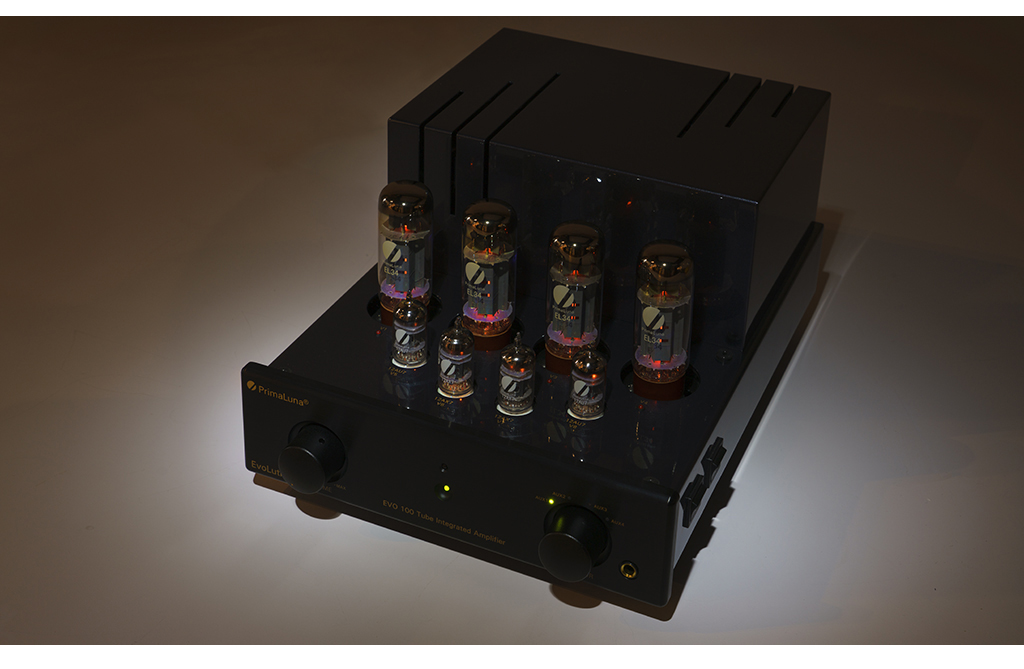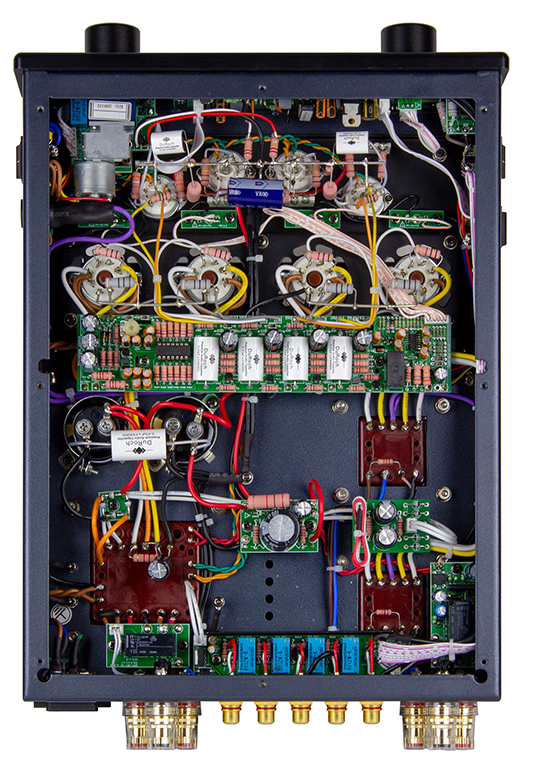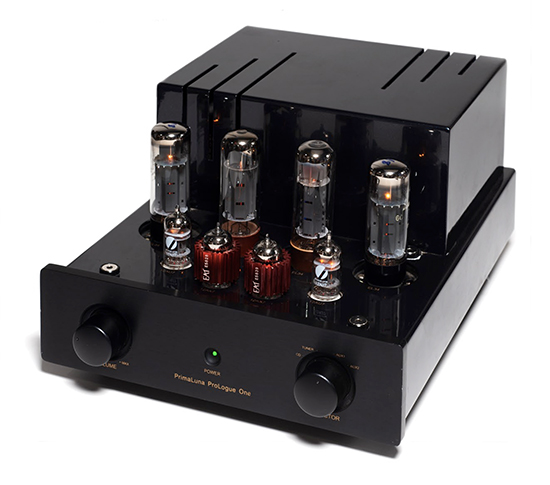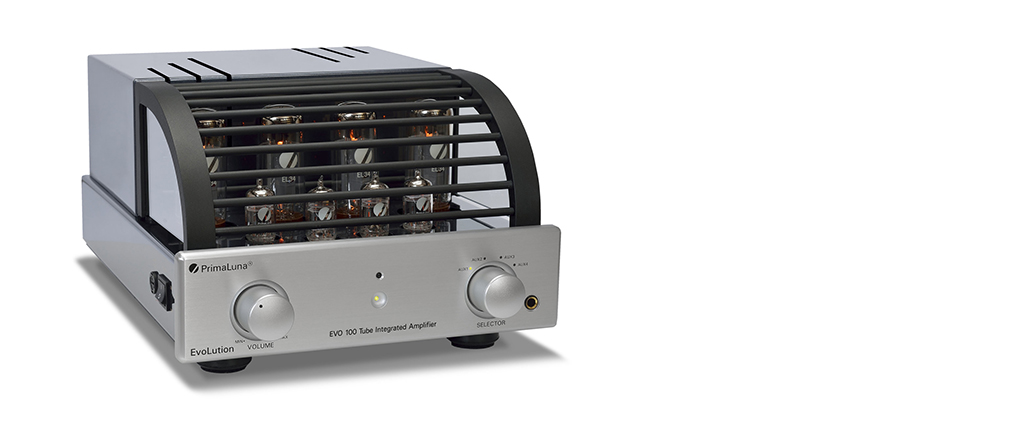REVIEW: The PrimaLuna EVO 100 Integrated Amplifier Things change, things stay the same
By Jeff Dorgay Listening to Dylan’s “Times They Are A Changin” reminds me of the original PrimaLuna ProLogue integrated amplifier that I reviewed for The Absolute Sound back in 2003. Man, that was the little amp that could.
Listening to Dylan’s “Times They Are A Changin” reminds me of the original PrimaLuna ProLogue integrated amplifier that I reviewed for The Absolute Sound back in 2003. Man, that was the little amp that could.
With just under 35 watts per channel, it offered a combination of new and old school sound, along with a level of build quality that precious few $5,000 amplifiers had. Yet the PrimaLuna was $1,095. Almost 18 years later, this amplifier still works flawlessly and sounds great.
However, time marches on, and fortunately the things that made PrimaLuna an amazing upstart have stayed firmly in place. Putting the two amplifiers side by side for the photos, there’s no evidence that they’ve cut corners in the casework anywhere. If anything, the current casework is a more refined version of the original, and a basic remote control is now part of the package, as is a headphone jack. Our test version even has a PrimaLuna installed MM phono stage, which only adds about $350 to the price – and it’s worth every penny. You’ll pay that much for an interconnect to add an outboard stage. Top value remains a pillar of the brand.
The EVO100 may look similar to the ProLogue 1 at first blush, but under the chassis, the components have been constantly improved. There are even higher quality capacitors, a power supply with more reserve, along with better transformers too. While the price has doubled in 18 years, if you adjust for inflation, the current amplifier is really only 50% more expensive. PrimaLuna has not scrimped one bit on the actual assembly quality of their amplifiers. The cleanliness of their point to point wiring is some of the best going.
For those who don’t want to read all the way to the end, the new EVO is a very worthwhile upgrade. If you’ve got one of the original ProLogues, now might just be the time to trade up. This is a good jump in performance.
Letting both amplifiers warm up for an hour, using the new T+A 2500 DAC/Streamer/SACD player (via Roon and Qobuz) as a source, and the Dynaudio Confidence 20 speakers, the difference is vast. Everything we were enamored with in the original is here in spades: great midrange, a vast soundstage, and a saturated tonality that is just right. In the review system, it’s tough to tell the difference 8 watts makes, but it’s not about that.
The new amplifier is much more extended, with much more detail from top to bottom. In the past, PrimaLuna made a ProLogue and a DiaLogue series, with the latter having better components and offering a step up in performance over the entry level. Most noticeably, and has been the case going forward with the PrimaLuna models is an increase in bass performance, without sacrificing the lovely midrange response that draws a music lover to tubes in the first place.
Along with the Dynaudios, I achieved excellent results with a pair of Eggleston Nicos, the Focal Kanta no.1s and another perennial favorite here, the JBL L-100 Classics. You’ve probably noticed that I haven’t paired this amp up with any budget speakers – it’s that good. The EVO 100 is right at home with a pair of premium speakers, and if you aren’t playing music at ear splitting levels, it may be all you need.
Listening to the bass control in Kruder & Dorfmeister’s “Don Gil Dub,” shows off the improvement that power supply makes – right now. If you happen to be a K&D fan, you know how spacy their recordings tend to sound. Seguing into Thorne Miller’s “Soul Man” delivers even more bass grunt, and shakes a few things on the shelving unit near by. Great stuff. Perhaps this isn’t as telling as a violin solo (though this amplifier does an awesome job there too) but it is a real marker for the cool factor a great vacuum tube amplifier brings to the party. This amplifier has that big, airy, nearly psychedelic feel to it and that’s a great thing.
Speaking of tubey-ness, swapping the T+A DAC for the PrimaLuna EVO DAC makes for a slightly less dynamic, but even yummier sound. If you aren’t a crazed analog person, this combination is so synergistic, you could be persuaded to forget about vinyl – seriously. We’ll have a full review on the EVO DAC shortly.
If you have to spin records
In the context of the EVO 100s MSRP, the extra $300 that the phonostage will set you back is perfect for someone with a modest turntable, or a streaming lover wanting just enough vinyl to have fun with. Add a $500 – $800 table (new or vintage) and rock. We paired the onboard phono with a Technics SL-1200 and NOS Shure M44. Woo hoo. This was an absolutely engaging combination, especially with the JBLs (which you can get from Kevin Deal at Upscale Audio to go along with your EVO100.)
Playing a ton of classic rock through the EVO100/Technics/JBL combination just feels so right. This little 40 wpc amplifier plays way louder than one would ever expect it to, and it ticks all the boxes for sound and style. Dusting off the Dynaco Stereo 70 for a quick comparison really leaves the vintage amp lacking. Frampton Comes Alive and Rumors were never so much fun.
Perfectly balanced
There’s only one caveat with the EVO100, it really needs an hour’s worth of warming up to deliver maximum sonic effect. Think I’m kidding? Turn it on and play your favorite track. Then come back to it in an hour and listen – the difference is not subtle. The room just got a lot bigger.
 Much like a great motorcycle or sports cars, there are hifi components that bowl you over with a single aspect of their performance, yet I submit the ones you remember the most (the true classics) are the ones that perform well across the spectrum. The EVO100 is one of those special components. There are tube integrated amplifiers that offer more power and more finesse, but they all cost a lot more than the $2,295 the EVO 100 will set you back. This amplifier is so good, you can start with a budget pair of speakers, yet grow up to a $5,000-ish pair of speakers and not feel like you need another amplifier. That’s value.
Much like a great motorcycle or sports cars, there are hifi components that bowl you over with a single aspect of their performance, yet I submit the ones you remember the most (the true classics) are the ones that perform well across the spectrum. The EVO100 is one of those special components. There are tube integrated amplifiers that offer more power and more finesse, but they all cost a lot more than the $2,295 the EVO 100 will set you back. This amplifier is so good, you can start with a budget pair of speakers, yet grow up to a $5,000-ish pair of speakers and not feel like you need another amplifier. That’s value.
No matter what kind of music you enjoy, the EVO 100 will deliver great sound. If it’s your first experience with vacuum tubes, especially if you are stepping up from a more mass market receiver or amplifier prepare to be amazed. While PrimaLuna products deliver more fun for the dollar than anything we’ve used, they also have 20 years of manufacturing expertise behind them and some of the best reliability in the business. There are other great tube amplifiers out there to be sure, but no one makes a more robust amplifier than PrimaLuna.
Thanks to being very well designed and built, the EVO 100 is easy on tubes. Again, from my experience with a number of their amplifiers over the years, even with heavy use, you might even see five or more years out of a single set of tubes. That is value and consideration for the customer.
Final touches
As they used to say on those old TV shows, “but wait there’s more.” The EVO 100 still has a few more features. First, the remote. Granted, most of us can use a few more steps in our daily routine, but having a remote is handy. Especially when you’re streaming a long selection of tracks where the volume can jump up and down dramatically. The remote included with the EVO 100 is basic, but built to the same standard as the ones in the larger EVO series components.
Next, the internal headphone amplifier. As in the bigger PrimaLuna amplifiers, the EVO100 actually uses the tube circuitry to power the headphones, and is not a small, op amp board that is added on, sounding nothing like the amplifier you’re used to listening to. A cursory audition of some Grado, Audeze, and B&W phones all proved pleasant. None of the phones in my collection presented an issue to drive, and again, if you are of the headphone persuasion, you’d easily pay some serious coin to get a headphone amplifier sounding this good. Merely use the switch on the right side of the amplifier to go from LS (loudspeaker) to HP (headphones).
One thing missing on my original ProLogue amplifier was a bias switch to recalibrate the Adaptive Auto Bias circuit to apply a bit higher bias to 6550, KT 88, and KT 120 power tubes. The low bias position is more suited for the EL34 tubes that the EVO 100 is shipped with. It probably even squeaks a few extra watts out with KT88s, but the tonal quality is different.
The different sonic characters available with different tubes, is more than another article, so perhaps we’ll pick that up in an upcoming article or video, so stay tuned. Either way, this is another aspect of PrimaLuna ownership that really ups the fun factor. With it so easy to swap tubes, both small signal and output – it’s easy to fine tune your EVO100 exactly to your taste. Me, I’m not a big tube roller anymore, and vintage NOS EL34s are prohibitively expensive. But if you have to go down that rabbit hole, it can be as long of a journey as you’d like it to be. Not to mention Kevin Deal and Upscale Audio have the biggest stash of tubes on the planet, so their staff can help you with your journey.
Though PrimaLuna’s entry level tube integrated has crept up in price in almost 20 years, considering the increased sound quality and feature set, it remains one of the best bargains in high end audio. Again, an easy choice for one of our Exceptional Value Awards.
Digital Source dCS Bartok, T+A 2500, PrimaLuna EVO DAC
Analog Source Technics SL-1200mk. 5 w/Shure M44
Speakers Sonus faber Lumina 1, Focal Kanta no.1, Eggleston Nico, Dynaudio Confidence 20
Cable Tellurium Q Black Diamond
Power Torus TOT, Cardas Clear power cords





